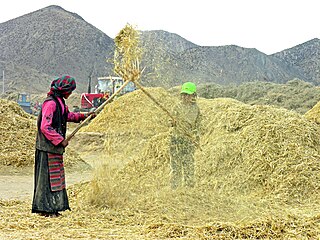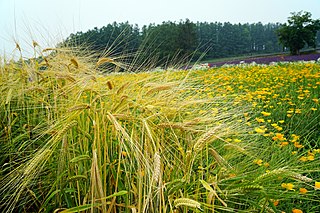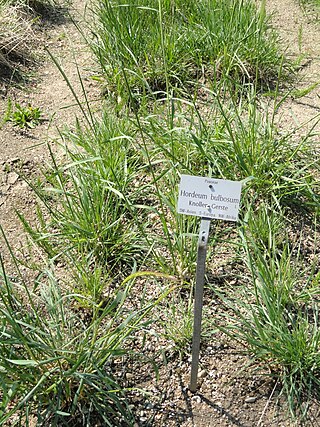
Hordeum is a genus of annual and perennial plants in the grass family. They are native throughout the temperate regions of Africa, Eurasia, and the Americas.

Hordeum jubatum, with common names foxtail barley, bobtail barley, squirreltail barley, and intermediate barley, is a perennial plant species in the grass family Poaceae. It occurs wild mainly in northern North America and adjacent northeastern Siberia. However, as it escaped often from gardens it can be found worldwide in areas with temperate to warm climates, and is considered a weed in many countries. The species is a polyploid and originated via hybridization of an East Asian Hordeum species with a close but extinct relative of Californian H. brachyantherum. It is grown as an ornamental plant for its attractive inflorescences and when done flowering for its inflorescence.

Hordeum murinum is a species of flowering plant in the grass family Poaceae, commonly known as wall barley or false barley. It is a close relative of cultivated barley.

Hordeum pusillum, also known as little barley, is an annual grass native to most of the United States and southwestern Canada. It arrived via multiple long-distance dispersals of a southern South American species of Hordeum about one million years ago. Its closest relatives are therefore not the other North American taxa like meadow barley or foxtail barley, but rather Hordeum species of the Pampas of central Argentina and Uruguay. It is less closely related to the Old World domesticated barley, from which it diverged about 12 million years ago. It is diploid.

Aegiceras is a genus of trees and shrubs from Southeast Asia, Malesia, Australia and the Pacific Island,. and in Australia, in the Northern Territory, Queensland, New South Wales, and Western Australia. They occur as mangroves in coastal or estuarine areas.

Hordeum brachyantherum, known by the common name meadow barley, is a species of barley. It is native to western North America from Alaska to northern Mexico, coastal areas of easternmost Russia (Kamchatka), and a small area of coastal Newfoundland.

A crop wild relative (CWR) is a wild plant closely related to a domesticated plant. It may be a wild ancestor of the domesticated (cultivated) plant or another closely related taxon.

Barley, a member of the grass family, is a major cereal grain grown in temperate climates globally. It was one of the first cultivated grains; it was domesticated in the Fertile Crescent around 9,000 BC, giving it nonshattering spikelets and making it much easier to harvest. Its use then spread throughout Eurasia by 2,000 BC. Barley prefers relatively low temperatures to grow, and well-drained soil. It is relatively tolerant of drought and soil salinity, but is less winter-hardy than wheat or rye.

Hordeum marinum, commonly known as sea barley or seaside barley, is a species of flowering plant in the grass family Poaceae.

Aegiceras corniculatum, commonly known as black mangrove, river mangrove, goat's horn mangrove, or khalsi, is a species of shrub or tree mangrove in the primrose family, Primulaceae, with a distribution in coastal and estuarine areas ranging from India through South East Asia to southern China, New Guinea and Australia.

In plants, a gland is defined functionally as a plant structure which secretes one or more products. This may be located on or near the plant surface and secrete externally, or be internal to the plant and secrete into a canal or reservoir. Examples include glandular hairs, nectaries, hydathodes, and the resin canals in Pinus.

Highland barley, Tibetan barley or Himalayan barley is the principal cereal cultivated on the Tibetan Plateau, used mainly to make tsampa and liquor (chang).

Hordeum spontaneum, commonly known as wild barley or spontaneous barley, is the wild form of the grass in the family Poaceae that gave rise to the cereal barley. Domestication is thought to have occurred on two occasions, first about ten thousand years ago in the Fertile Crescent and again later, several thousand kilometres further east.

Hordeum distichon, the common barley or two-rowed barley, is a cultigen of barley, family Poaceae. It is native to Iraq, and is widely grown throughout temperate regions of the world. Some authorities consider it a subspecies of six-rowed barley, Hordeum vulgare. It is the principal raw material for malting and brewing beer in Europe, as it is lower in protein than the six-rowed barley usually used in North America.

Hordeum bulbosum, bulbous barley, is a species of barley native to southern Europe, northern Africa, the Middle East and as far east as Afghanistan, with a few naturalized populations in North America, South America and Australia. Since 1970 it has been used in the Hordeum bulbosum Method to produce doubled haploid (DH) wheat and barley plants by crossing it with T. aestivum or H. vulgare, followed by the elimination of the H. bulbosum chromosomes from the offspring. These DH plants are important in breeding new varieties of wheat and barley, and in scientific studies. H. bulbosum is also being looked at as a source of genes for disease resistance and other traits for barley crop improvement.
Hordeum brevisubulatum is a widespread species of wild barley native to temperate and subarctic Eastern Europe and Asia. A halophyte, it prefers to grow in saline grasslands.

Hordeum secalinum, false rye barley or meadow barley, is a species of wild barley native to Europe, including the Madeiras, Crimea and the north Caucasus, northwest Africa, and the Levant. It has been introduced to Australia and New Zealand. An allotetraploid, it arose from ancestors with the Xa and IHordeum genomes.
Hordeum comosum is a species of wild barley in the family Poaceae. It is native to Chile and western and southern Argentina, and has been introduced to the Falkland Islands. A widespread perennial grass, it is an important forage as it is relished by sheep.
Hordeum muticum is a species of wild barley in the grass family Poaceae, native to the high central Andes; Peru, Bolivia, northern Chile, and northern Argentina, and introduced to Ecuador. A diploid, its closest relative is Hordeum cordobense, a lowland species with a more southerly distribution.
Hordeum cordobense is a species of wild barley in the grass family Poaceae, native to northern Argentina. A diploid found below 1,000 m (3,300 ft), its closest relative is Hordeum muticum, a highland species with a more northerly distribution.















